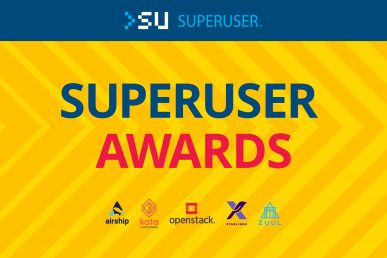SK Telecom, South Korea’s largest wireless carrier, has big plans to develop the 5th generation mobile network technology.
Superuser spoke to Jaesuk Ahn, project manager at SKT R&D about how software is supplanting the hardware-centric approach as network functions virtualization takes one step beyond.
Tell us about your role with SK Telecom.
I work at Network IT Convergence Lab, SKT, where I focus mostly on software-defined data center (SDDC) technologies like OpenStack. The Network IT Convergence Lab (NIC Lab) was established last year to create an All-IT Network. The All-IT Network is part of SKT’s vision that all network infrastructure and services will be virtualized and converged with IT technologies. With the All-IT Network, SKT will transform to the Intelligent Platform Company. SDDC is a core part of the All-IT Network, which NIC Lab will help make a reality for SKT.
As you may already know, Korea is one of the most connected countries in the world with extremely good mobile network connectivity. SK Telecom is the number one mobile service provider in Korea with a 50 percent market share. SKT has been at the forefront of developing and commercializing advanced wireless technology. For instance, we were the first to commercialize CDMA technology in 1990.
More recently, we were the first to deploy LTE and the LTE advanced network with maximum 375 Mbps, and we are working to develop the 5th generation mobile network technology. SKT has a strong vision to become an Intelligent Platform Company by 2020, focusing on four major platforms: MNO, Lifestyle, Media and Internet of things. In short, we have innovation in our genes.
What challenges do you face in creating the all-IT network?
Because it’s almost impossible to reuse existing hardware and software, SKT faces an enormous capital expenditure any time it deploys a new wireless network.
To ensure network nodes work during all periods, including peak traffic, telco network infrastructure tends to over provision network hardware and software. This is a very inefficient way to operate our wireless network, which requires telco to invest heavily to maintain the quality of its wireless network. Since each generation (2G, 3G, 4G LTE) is separate, built and operated separately, the complexity of operating them continues to rise.
What has been your experience dealing with vendor dependency?
Up until now, network equipment has been very specific. In other words, it has been a closed world. Even worse, software running on the network equipment has been highly proprietary. Unfortunately, this forces us to rely heavily on specific vendors.
The IT industry was the same in the past. However, with virtualization technology, cloud computing, and open source software technologies, IT was able to transform from a proprietary world to an open world. OpenStack has been the core of this transformation.
Telco network infrastructure has unique requirements regarding performance, stability, and reliability. It has struggled to adopt a best-of-breed or a de facto standard solution. However, with cloud technology maturing, with the introduction of more “carrier-grade” solutions, it is time to “actively” consider open technology based “software defined infrastructure” for Telco Network Infrastructure.
What are your business requirements?
Traditionally, mobile networks have been used for voice and data. Currently, they are used for video streaming, social networks and online payment. In the future, we envision the mobile networks will be used for rich immersive media such as augmented reality and virtual reality, and the Internet of everything. The telco network infrastructure must be more flexible and open to address and satisfy these rapid changes. That means the telco network must adopt software-defined technologies to be more flexible, adaptable, and open.
As you plan to lead again with 5G, how is software supplanting the old hardware-centric approach?
Regardless of 5G, SK Telecom has been providing cloud services for public and internal IT services for years and has already begun to bring in software defined infrastructure solutions to commercial services like vIMS, EPC for IoT, and T-OVEN.
We plan to apply these proven technologies to network equipment. And, in the long term, we intend to achieve software-defined data center (SDDC) based all-IT infrastructure, which provisions telecommunication service, internal IT service, and public cloud service on a unified ICT infrastructure.
To provide a variety of services in the 5G era, we believe that an open architecture based on software defined technologies is essential. Network slicing, which provisions multiple logical network topologies on top of one physical network, is a good example.
As a first step, we are considering converting to a software-defined core network. That is, legacy network appliances composed of closed hardware and vendor specific software will be virtualized on commercial off-the-shelf (COTS) by provisioning all network functions as a software module, or virtualized network function (VNF).
Provisioning a new service will be fast and easy with VNFs. This is an extension of service-oriented architecture, which was introduced in the IT area a decade ago.
SK Telecom will phase in software-defined technologies to the access network and the transport network as well as the core network. We are already working with international organizations for standardization like 3rd Generation Partnership Project (3GPP) for Cloud Radio Access Network (C-RAN), and also leading a global operator alliance to open RU-DU architecture.
What role is OpenStack playing in the new software-defined approach?
Telco network virtualization (e.g., network slicing and 5G Core Network/RAN virtualization) is a key feature in the upcoming 5G networks. NFV and SDN are key technologies to enable telco network virtualization.
NFV uses software-defined infrastructure technologies to achieve carrier grade network virtualization infrastructure. ETSI NFV ISG has already developed a reference architecture, and there is OPNFV to realize this NFV concept with various open source technologies. OpenStack is the top most key technology for that. From 5G’s viewpoint, network functions to construct various network services are the most important software. OpenStack is the “baseline infrastructure technology” as well as the “integration engine” to make and run these network functions. OpenStack was a clear choice for us because of its openness, growing community and the rich features it provides.
Telco network virtualization requires a stricter requirement standard for reliability, performance, and availability than IT infrastructure virtualization.
SKT is conducting research on software-defined technologies and services, mainly based on OpenStack. SKT is also deploying cloud services on top of OpenStack technologies. Along with all these research activities, SKT will work on preparing software defined technologies to meet with Telco’s strict requirements and service scenarios so SKT can use these technologies for network infrastructure virtualization to run various network functions for 5G networks.
Which OpenStack projects will be included in your 5G architecture?
As described above, OpenStack is not directly used for a 5G deployment right now. However, SKT is actively working on software-defined technologies based on OpenStack and other open source software projects.
The NIC Lab is the main entity to lead these R&D activities in SKT. 5G will leverage this software-defined technology developed by the NIC lab. Most core projects (Nova, Cinder, Neutron, Keystone, Glance, Heat) are included in SKT’s software-defined technology research.
Other OpenStack projects are also being reviewed based on SKT’s requirements and use cases. SKT wants to leverage all the relevant projects as much as possible. The most important project NIC lab is working on is Neutron and the ONOS project to make the ONOS-based SDN controller. SKT hopes to contribute to both ONOS and OpenStack community to make Neutron more reliable and production-ready, especially regarding Telco’s specific needs.
Just how fast is 5G, and when do you expect it to be available?
We expect 10~100X to be faster than 4G LTE, 10x lower latency, and 100~1000x to offer more capacity than 4G LTE. We expect to have a 5G phase one standard by late 2018.
However, SKT is planning to have a 5G-grade pilot service in early 2018 as a leading operation in the 5G domain. Official commercialization of the 5G network will be after 2020. We also expect the first commercialization will happen in a large city where there are lots of customer needs, with mission critical IoT application.
What is SKT’s vision toward the 5G era?
For SKT, 5G is not just another faster network infrastructure. 5G is SKT’s chance to transform from a “network” to a “platform” company. SKT is not only doing a technical research on 5G network technologies, but also focusing on the real value SKT can give to its users; from a person’s lifestyle to an innovation that improves enterprise’s productivity. To achieve that, SKT will present various possibilities we can have on top of the 5G network, such as entertainment like a virtual reality-based game and video, and massive and mission critical IoT.
SKT cannot do this alone. SKT will open the 5G Service Platform to third parties and customers to achieve its dream to become a platform company. SKT and other telcos made the mistake to sit in a walled garden. However, SKT will not make the same mistake twice. With the new possibility brought by the 5G network, SKT will be more open and more innovative. More importantly, this will not be possible without open source technologies and an eco-system, such as the OpenStack community.
What can you tell us about your current projects with OpenStack?
The first application of OpenStack-based SDDC has been applied to our Bundang Network Operation Center. We have developed a multi-cloud datacenter operation system that we call TROS to manage development and NOC servers in our NOC. We have also employed OpenStack in our private cloud 2.0, which will be used for mobile service development. This is a big change from our previous private cloud that was built on top of a vendor-specific solution. In our private cloud, we will also have Cloud Foundry as a PaaS platform to support mobile application developers. We are also building our public cloud service based on OpenStack. It will be our chance to prove open architecture with open source technologies can fully compete with a vendor-specific solution.
SDN is an important technology for a network provider like us. We are engaged with the ON Lab at Stanford, which develops ONOS, an open source project to develop a carrier-grade SDN controller. We are happy to announce our simplified open networking architecture (SONA) project will be the core component to connect ONOS to OpenStack via the Neutron API.
Managing software-defined networks is a challenging task due to complex overlay structures. To help network operators, we are developing a 3D network operation system. It can visualize complex virtual networking structure in a more intuitive way than a traditional network management dashboard can. But what’s more, it can complete the feedback loop by allowing network operators to take actions as they discover problems through the SDN controller.
These are just a few examples how OpenStack and software-defined technologies will be leveraged in the next generation mobile networks, as well as our cloud services. We have been working with many partners to develop these technologies. They include HP, Intel, and Mellanox.
What are you learning from others in the community?
SKT is learning how others have been through cultural changes to embrace open source technologies as well as cloud computing services. Working with open source software and the community [requires] change to our own genes as a traditional network operator. Personally, whenever I come to an OpenStack Summit, l learn that OpenStack is not just software, it represents an open culture, a strong passion and harmony…
This post is part of our focus on OpenStack innovators. If you’d like to be featured, write to [email protected]
Cover Photo // CC BY NC
- How OpenStack is helping SK Telecom roll out the next 5G LTE network - February 9, 2016
- Enter Fulfills Vision of Becoming a True Open Cloud Provider - July 15, 2014
- GoDaddy Builds Their Open Cloud with OpenStack - July 9, 2014

)










